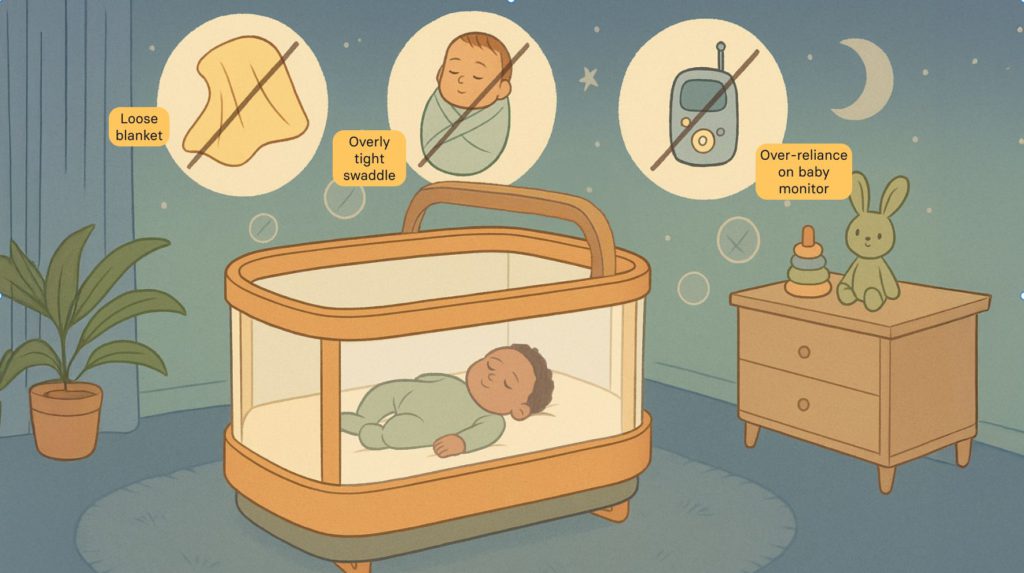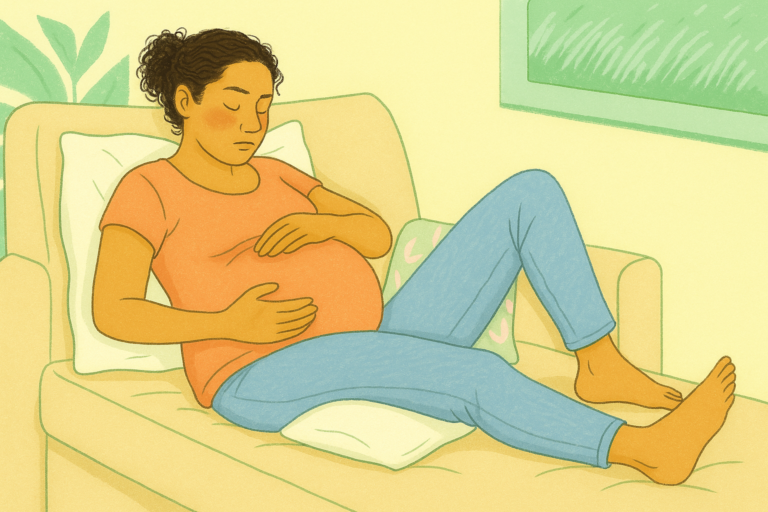September is the Baby Safety Month, a reminder that even the tiniest details of infant care matter. From sleep habits to baby monitors, safety is non-negotiable. Yet, despite research and awareness campaigns, some myths about sleep, swaddling, and baby monitors still linger and may put little ones at risk.
In this blog, we’ll bust five common myths, explain what experts actually recommend, and share safety tips every parent (or expectant mother preparing for their September baby) should know.
Myth 1: “Babies sleep safest on their sides.”
The truth: The American Academy of Pediatrics (AAP) has long stated that the safest position for sleep is on the back, for every nap and at night. Side sleeping increases the risk of rolling onto the tummy, which raises the risk of suffocation.
Safety tip: For every nap and bedtime, put your baby on their back in their own crib or bassinet, using just a firm mattress and a fitted sheet. This simple step is one of the strongest protections against Sudden Infant Death Syndrome (SIDS).
This is where modern sleep solutions like smart cribs help parents transition safely. Instead of relying solely on swaddling, smart cribs can provide gentle rocking or white noise – soothing without restricting your baby’s natural movements.

💥 BLACK FRIDAY SALE 💥
Smarter Sleep for Your Baby
An award-winning crib—loved by parents, approved by experts.
0 to 24 months of use
Automatic soothing
Built-in video & sound machine
AI-powered sleep insights
Customizable soundtracks
Get 2 extra hours of sleep nightly
Myth 2: “Swaddling keeps babies safe through the night.”
The truth: Swaddling can help soothe a newborn, but it isn’t automatically safe. Tight swaddles can lead to hip dysplasia and are also a suffocation risk once babies begin to roll. If the swaddle is too tight around the hips or continues past the stage when babies start rolling, it can lead to hip dysplasia or suffocation risks.
Safety tip: Keep swaddles snug around the arms but loose around the hips. As soon as your baby starts showing signs of rolling, sometimes by 2 months, it’s time to transition out of swaddling. Instead, switch to a sleep sack or wearable blanket for safe sleeping.
Myth 3: “Monitors prevent accidents.”
The truth: Baby monitors, whether audio, video, or those tracking oxygen levels are tools for peace of mind. They are not recommended to prevent SIDS. Relying solely on monitors can create a false sense of security.
Safety tip: Think of monitors as an extra set of eyes and ears, not a replacement for safe sleep habits. The Baby Safety Alliance reminds parents that monitors should complement, not replace a safe sleep environment.
Myth 4: “Soft bedding makes sleep more comfortable.”
The truth: Though they may look cute or cozy, things like pillows, bumpers, and plush toys don’t belong in the crib, they raise risks instead of comfort. These items can block airways or cause overheating.
Safety tip: A crib should be simple: a firm mattress, a fitted sheet, and nothing else. If you’re tempted to add more, remember the golden rule: Bare is Best.

💥 BLACK FRIDAY SALE 💥
Smarter Sleep for Your Baby
An award-winning crib—loved by parents, approved by experts.
0 to 24 months of use
Automatic soothing
Built-in video & sound machine
AI-powered sleep insights
Customizable soundtracks
Get 2 extra hours of sleep nightly
Myth 5: “Car seats double as safe sleeping spots.”
The truth: While car seats are essential for travel safety, they aren’t designed for prolonged sleep outside the car. Babies can slump forward, restricting airflow and putting them at risk.
Safety tip: If your baby falls asleep in the car seat, move to a safe, flat sleep surface as soon as you arrive. Think of the car seat as transportation safety, not a crib replacement.
Why does baby safety month matter?
Each September, Baby Safety Month raises awareness, educates parents, and encourages safety checks at home. Supported by the Baby Safety Alliance, it’s a time when manufacturers, healthcare professionals, and communities work together to spread safety messages.
Whether it’s sharing safety tips on social media or checking your baby gear for recalls, these small actions protect lives. For parents and caregivers, it’s also a chance to re-evaluate daily routines, bust old myths, and focus on what truly keeps babies safe.
Conclusion
At the end of the day, keeping your baby safe isn’t about following every trend or tradition. It’s about sticking to what science and experts know works. Myths can feel comforting, but facts protect little lives. This Baby Safety Month, give yourself the gift of peace of mind: follow evidence-based practices, trust your instincts, and know that the safest sleep is often the simplest.
FAQs
Q: 1. Is it safe to swaddle my baby all night?
A: Yes, but only if your baby is not yet rolling. Swaddle snugly around the arms, keep the hips loose, and stop swaddling once rolling begins to avoid suffocation risks.
Q: 2. Do baby monitors reduce the risk of SIDS (Sudden Infant Death Syndrome ?
A: No. Monitors provide peace of mind, but they don’t prevent SIDS. The safest way to protect your baby is to follow safe sleep guidelines: back to sleep, firm mattress, and no loose bedding.
Q: 3. When should I stop swaddling my newborn?
A: You should stop swaddling as soon as your baby shows signs of rolling, which may happen as early as 2 months. At this stage, switch to a sleep sack or wearable blanket.
Q: 4. What’s the safest sleeping position for infants?
A: Always place your baby on their back for sleep, both at night and during naps. This position is proven to reduce the risk of SIDS.
Q: 5. Is it okay if my newborn naps on my chest?
A: Contact naps can be comforting, but always supervise closely. For longer or unsupervised naps, place your baby in their crib or bassinet to reduce risks.
Q: 6. Can my baby sleep in a car seat at home?
A: Car seats are designed for travel safety, not prolonged sleep. Once the trip is over, move your baby to a flat, safe sleep surface like a crib or bassinet.
Q: 7. If my baby has reflux, should they still sleep on their back?
A: Even with reflux, the AAP recommends placing babies on their backs to sleep. This position does not increase choking risk, and if reflux is severe, consult your pediatrician.
Sources
- Safe sleep position and swaddling safety and when to stop. American Academy of Pediatrics (AAP). “Safe Sleep Guidelines”
- Dangers of soft bedding. CDC(Centers for Disease Control and Prevention). “Infant Safe Sleep”
- Car seats are not for prolonged sleep. NIH/NICHD. “Safe to Sleep® Campaign”
- Role of monitors in safe sleep, Importance of Baby Safety Month. Baby Safety Alliance. “Safe sleep product guidelines”
- Safe sleep even with reflux. HealthyChildren.org (AAP’s parent site). “Practical advice for reflux and safe sleep”




